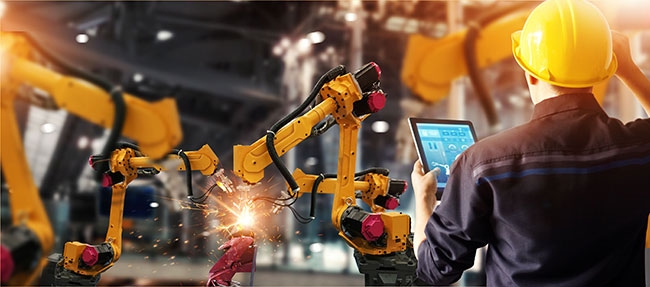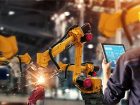
Features
Fabrication
Innovations
Operation optimization The state of artificial intelligence
July 30, 2019 By Andrew Snook
 Industrial AI is still in its infancy, but future applications may include deep process optimization, improved control of robotics and safety enhancement. Photo: Adobe Stock
Industrial AI is still in its infancy, but future applications may include deep process optimization, improved control of robotics and safety enhancement. Photo: Adobe StockIf you were to ask the leaders within the fabricating and manufacturing sectors how important artificial intelligence is for the future success of their companies, most of them will tell you it’s a critical component. That said, just how far along are we in the evolution of A.I. in these sectors?
“I work with at a lot of different plants in manufacturing, as well as fabrication companies, and a lot of them are actually trying to figure out exactly where A.I. falls into place,” says Alexander Wong, associate professor at the University of Waterloo and Canada research chair in artificial intelligence. “There are some very interesting places where it can really help be a game changer in improving efficiency and quality, as well as just managing logistics.”
Wong says that many of the most recent advances in A.I. have been related to machine learning. He says companies are taking advantage of vast amounts of collected data that they’ve acquired from their manufacturing and fabricating operations and are using it to make better decisions.
“By feeding this mass wealth of data, and instructing the machine learning algorithms to make predictions based on the data, you’re able to greater improve the efficiency and quality of the products that get manufactured,” he says.
Craig Resnick, a vice-president within the ARC advisory group (a technology consultancy), says that A.I. grows as part of an evolution, not a revolution, within the manufacturing and fabricating sectors, and that companies that are getting to the stage where they want to deploy any sort of A.I. solutions need to look to their historical data.
“You combine that with some of the analytic tools that are available today from analytics software providers and that at least gives you the foundation for pattern recognition and the ability to kind of help make decisions based on historical outcomes,” Resnick explains. “What we’re really seeing at this point is it’s not so much that all these processes are now running all by themselves because of the history, but what we see is the ability to integrate some of the historical information, and use it with tools such as augmented reality and mixed reality. So it’s providing data to the operators and maintenance people to help them make better decisions. But also comparing what they’ve seen in the real world, and helping them make decisions based on what’s happened in the past.”
No data? Then start collecting
If a company doesn’t have a vast amount of historical data to draw from, this doesn’t mean it still can’t embrace the use of artificial intelligence for its operations.
“The main thing we would do is recommend – before they go A.I. – to focus on the biggest business problem they have,” Resnick says.
In glass manufacturing, as with other manufacturing industries, the No. 1 issue for most companies is unscheduled downtime.
“They’ll say, ‘We can’t make glass because a motor has failed or a conveyor has failed.’ So what we will suggest is to invest in some low-cost sensors that you can install on some of their rotating equipment, such as the gearbox of a motor that might drive a conveyor,” Resnick adds. “So if we can now figure out when those bearings are running too hot, or when the gearbox oil is running too hot, or has lost its viscosity, or there are filings in the oil bath, then the company can go ahead and have a scheduled downtime to replace the problem rather than wait until a failure – where now you’re in a crisis mode to try to get a repairperson or a maintenance person and replacement parts.”
Once a company starts to collect this type of data through its automation systems, it can then invest in a software package that analyzes the data to help with future decisions. As a company collects these vast amounts of data, the next step is to find an artificial intelligence solution that can mine that data and help the company’s manufacturing operation make better decisions based on factors like raw materials, time of day, and the temperature and humidity of its plant.
“That way, when there is a problem that causes downtime, you can now almost take a snapshot as to what happened at that time and say, ‘Maybe we need to run the plant a little bit warmer or a little bit cooler,’” Resnick explains. “That is the kind of thing you can learn through artificial intelligence.”
In some cases, artificial intelligence has found that a manufacturing operation running too fast is the root of its problems.
“Sometimes plants actually slow down their production because what they find is when they start producing at higher rates their overall equipment effectiveness may begin to fall,” Resnick says. “So then they find that if they scale back and slow the manufacturing process down, they’re actually more profitable. Even though they’re producing a little slower, what they’re producing is going to be more first-run quality.”
Having this kind of information at one’s fingertips can help a plant manager understand it is not always desirable to run equipment at its full capacity, 24/7, which is a natural instinct for most companies looking to get as quick a return on their investment in equipment as possible.
“Sometimes with artificial intelligence you’ll find out these problems. And by having all this data, you may get information that says if we run at 95 per cent capacity rather than 100 per cent capacity it turns out we have better first-run quality,” Resnick says. “It may also take into account energy prices and give the feedback that you need to do more of that heavy energy consumption manufacturing certain times of the day because the electric rate is less. It really is a great tool to learn your business, but if you don’t have the history it’s really difficult to make the best decisions.”
Connecting the supply chain
Another reason manufacturers leverage A.I. is to connect their supply chains from the raw materials being supplied and the transportation of those raw materials all the way through the process to the expected demands of customers.
“You certainly don’t want to be building up any inventory and having most of those costs on the books. You want to be as close as possible to just-in-time manufacturing, but at the same time finding that balance between what is your customer demand and availability of material and the transportation aspects of the raw material,” Resnick says. “That’s really where it helps, because by accumulating that data, you might know the certain materials that are used in the manufacturing of your product, based on the vendor, based on the time of day, based on the time of year… and that might affect how to set up some of the parameters of your manufacturing.”
Robots and A.I.
When it comes to robotics in the factories, the number of errors they commit tends to stem from a combination of the amount of historical data they have access to and how well equipped the robots are with the appropriate sensing technologies.
“You can’t make all your decisions based on history. At the same time, you can’t make all your decisions based on what the robot sees in front of it,” Resnick says.
To solve this problem, the best solution is often collaborative robotics, where a robot works alongside an employee.
“We find that does a better job of training the robot,” Resnick says. “If the robot is learning on the job based on different scenarios and the worker is kind of helping it do the right thing, that really helps to make sure that the best data for future use is being stored and helping the robots on their job history.”
The human working alongside the robot is also more likely to detect unique one-off type of scenarios that the robot was not programmed to deal with.
“That’s really where the collaborative robot has the opportunity to learn,” Resnick says. “So we find that it’s better in collaborative robotics that are really highly instrumented with sensors to at the same time have the ability to take real-time input from the operator that’s working alongside it. That is where we tend to be very enthusiastic.”
Safer operations
Another other area where people have been using artificial intelligence to optimize aspects of their operations is safety.
Wong says that companies are using A.I. as a surveillance tool in their plants.
“Plants are leveraging machine learning and computer vision to kind of survey the area using cameras to make sure everyone has their safety equipment, that certain equipment is working as it should be, and that there are not any hazardous scenarios happening,” he says.
These days, it seems the most hazardous scenario a fabricator can be involved in is failing to embrace A.I. as a key part of its future planning. •
Print this page

